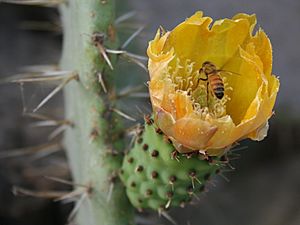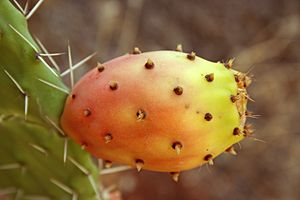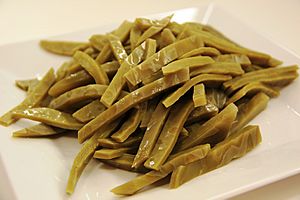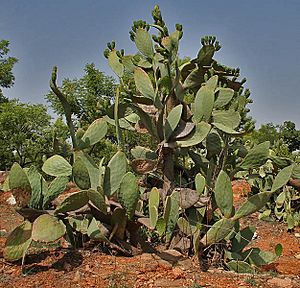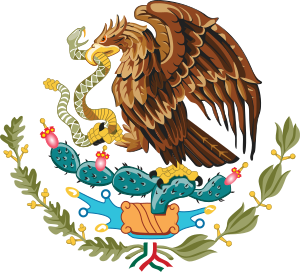Indian fig opuntia facts for kids
Quick facts for kids Indian fig opuntia |
|
|---|---|
 |
|
| Conservation status | |
| Scientific classification | |
| Genus: |
Opuntia
|
| Species: |
ficus-indica
|
| Synonyms | |
|
|
The Opuntia ficus-indica, often called the Indian fig opuntia or prickly pear, is a type of cactus. People have grown this plant for a very long time. It is an important crop in dry and semi-dry parts of the world.
This cactus is the most common and important type of cactus grown for business. It is mainly grown for its fruit. It is also grown for its flat stems, called nopales, which are eaten as a vegetable. Cacti are great plants for dry areas. They are good at turning water into plant material. In Mexico, the prickly pear is as important as maize (corn) and blue agave. Scientists believe O. ficus-indica first grew in central Mexico. Its closest plant relatives are found there.
Contents
What is a Prickly Pear?
Most people who talk about "prickly pear" fruit mean this specific type of cactus. The Spanish name for the fruit is tuna. This name is also used for other Opuntia cacti. The word tuna came from the Taíno language around the year 1500.
Other common English names for the plant and its fruit include Barbary fig and cactus pear. In Mexican Spanish, the plant is called nopal. This name is also used in American English for cooking. In Spain, the fruit is often called higo chumbo and the plant chumbera.
Plant Description
The prickly pear is a plant that can grow in many ways. It can produce both male and female parts on the same plant. It can also fertilize itself. Opuntia cacti grow in dry places, so they need to save water. They have special adaptations for this, like being succulent. This means they store water in their thick parts.
This plant is a perennial shrub. This means it lives for many years. It can grow up to 5 meters (about 16 feet) tall. It has thick, fleshy, and flat stems called cladodes. These stems are shaped like paddles. The plant has a waxy outer layer that keeps water in and reflects sunlight. Stems that are one or two years old produce flowers. The fruits can be different colors, from light green to deep red.
The flowers come in three colors: white, yellow, and red. They usually appear in early May and last through early summer in the Northern Hemisphere. The fruits are ready to eat from August to October. People usually chill the fruits in a refrigerator for a few hours before eating them. You need to peel off the thick outer skin. The fruit tastes a bit like sweet watermelon. The bright red, purple, white, or yellowish inside has many tiny, hard seeds. Most people swallow these seeds, but some people might find them hard to digest.
How People Use Prickly Pear
Eating Prickly Pear
People around the world eat O. ficus-indica as food. The fruits are sold in many places. They are often eaten raw. They have a lot of vitamin C, more than almost any other fruit. The young "leaves" (which are actually the flat stems, or cladodes) are cooked and eaten as a vegetable. They are called nopalitos. People slice them into strips, with or without the skin. They can be fried with eggs and jalapeños for breakfast. They taste and feel a bit like green beans.
You can boil the fruits or stems, eat them raw, or blend them into juice. They can also be cooked in a frying pan and served with chicken or added to tacos. People also make jams and jellies from the fruit. These taste and look like strawberries and figs. In Mexico, people sometimes use Opuntia fruit to make an alcoholic drink called colonche.
In Sicily, Italy, there is a prickly pear-flavored drink called ficodi. It tastes a bit like a medicinal aperitif. On the island of Malta, a drink called bajtra is made from this fruit. You can find the prickly pear growing wild almost everywhere there. On the island of Saint Helena, a local drink called Tungi Spirit is also named after the prickly pear.
Animal Feed
In the Southwest United States, farmers have started growing O. ficus-indica to feed cattle. They also use it to make fences. Cattle usually eat a type of cactus that does not have spines. The cactus pads do not have a lot of dry material or protein. But they are very helpful as extra food during dry times. The cactus also has a lot of water. This means farmers do not need to give cattle extra water during a drought. Many wild animals also eat the prickly pear. In very dry years, people sometimes burn off the spines of wild prickly pear plants. This makes them safe for animals to eat in an emergency.
Stopping Soil Erosion
O. ficus-indica is planted in hedges to help stop erosion in the Mediterranean Basin. Erosion is when soil is washed away by water or wind. These hedges are cheap but work very well. Under these hedges, the soil becomes much better. It has more nitrogen and organic material. The soil becomes more stable, so less water runs off, and less soil washes away. The soil can also hold more water and let water pass through it better.
Prickly pear farms also help other plants grow. They make harsh environmental conditions better. This helps other plants start growing and develop. In Tunisia and Algeria, O. ficus-indica is used to slow down and guide sand movement. It also helps bring back plant cover. Its deep, strong roots help keep built terraces from falling apart.
Other Uses
The plant can be used in adobe to help bind and waterproof roofs. O. ficus-indica (and other similar cacti) are grown in special farms called nopalries. These farms raise cochineal insects on the cacti. These insects produce beautiful red and purple dyes. People have been doing this since before Columbus came to the Americas.
The slimy substance from prickly pear, called mucilage, might work as a natural, non-toxic way to clean up oil spills. Mexico has a small factory that has been making biofuel from Opuntia plants since 2016.
Growing Prickly Pear
Where it Grows
One important use for O. ficus-indica is for its large, sweet fruits, called tunas. Mexico is a big area where tunas are grown. The cactus grows wild and on farms. It can reach heights of 12 to 16 feet (about 3.6 to 4.8 meters). In Namibia, O. ficus-indica is a common plant that can handle dry weather. It is used to feed animals. O. ficus-indica grows in many places around the world that do not have frost, including the Southern United States.
However, prickly pears can be a big weed problem in some parts of Australia. This is especially true in southeast Queensland, parts of New South Wales, Victoria, and southeastern and eastern South Australia.
How it Grows
This plant is considered an invasive species in northern Africa. This means it grows quickly and can take over areas. Things that limit how well prickly pear grows are rainfall, soil, air humidity, and temperature. It needs at least 200 millimeters (about 8 inches) of rain per year. This is true as long as the soil is sandy and deep. The best conditions for growth are 200 to 400 millimeters (about 8 to 16 inches) of rain per year.
O. ficus-indica does not like too little oxygen around its roots. So, it needs soil that drains water well. It is also not good at handling high salt levels in the soil. Its growth might stop if there is too much salt. O. ficus-indica usually grows in areas where the air humidity is above 60%. It does not grow well in places where humidity is less than 40% for more than a month. The average daily temperature needed for it to grow is at least 1.5 to 2.0 °C (about 35 to 36 °F). If it gets too cold, like -10 to -12 °C (about 10 to 14 °F), its growth stops, even if it is only for a few minutes. The prickly pear can handle temperatures above 50 °C (122 °F).
Harvesting and Preparing
The fruits of O. ficus-indica are delicate. They need to be picked carefully by hand. The small spines on the fruits are removed by rubbing them on a rough surface or sweeping them through grass. Before you eat them, you need to peel them.
The flat stems (pads) of the plant are mostly used as animal feed. They also need to be harvested by hand. The pads are cut with a knife where they join the plant. If O. ficus-indica is grown to feed animals, types without spines are preferred. But wild types with spines are also used. In these cases, the spines must be removed from the pads so animals do not get hurt. This is usually done by burning the spines off the pads.
Nutrients in Prickly Pear
O. ficus-indica is valuable for both people and animals because it has a lot of water. In dry places, it contains about 85% water. This makes it a good water source for wildlife. The seeds in the fruit have 3–10% protein and 6–13% fats. Most of these fats are linoleic acid. However, the seeds can be hard to chew and might cause constipation. Because of this, some studies in Italy and Mexico are trying to find ways to grow prickly pear fruits with fewer seeds.
The fruit has vitamin C (about 25–30 mg per 100 g). Because of this, it was once used to help prevent scurvy, a disease caused by not enough vitamin C. Opuntia also contains selenium, which is a mineral.
The red color of the fruit and its juice comes from natural pigments called betalains. These include betanin and indicaxanthin. The plant also has other helpful plant compounds called flavonoids. These include quercetin, isorhamnetin, and kaempferol.
Where Prickly Pear Comes From
Scientists have studied the DNA of O. ficus-indica. They found that it was first grown by people from Opuntia species that grew naturally in central Mexico. Old records, like the Codex Mendoza, show pictures of Opuntia cladodes (stems). They also show cochineal dye, which comes from insects that live on Opuntia. These records were part of the tribute (payments) made to the Aztecs.
The plant spread to many parts of the Americas before Christopher Columbus arrived. After Columbus, it spread to many other parts of the world. It is especially common in the Mediterranean region, where it now grows wild.
See also
 In Spanish: Nopal para niños
In Spanish: Nopal para niños




